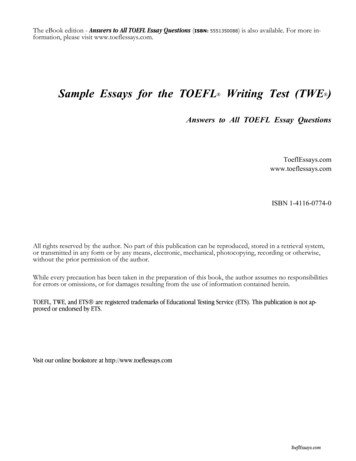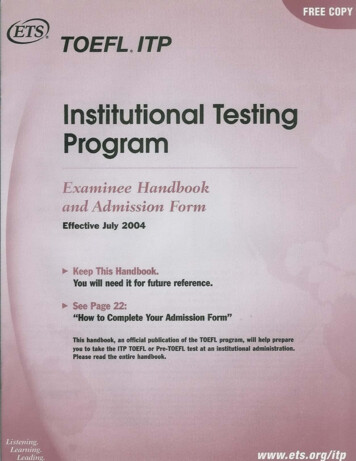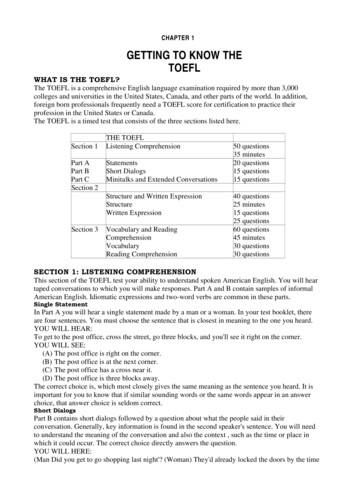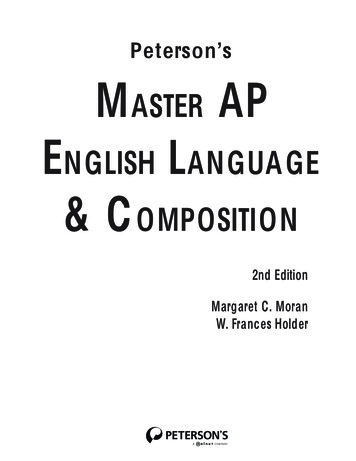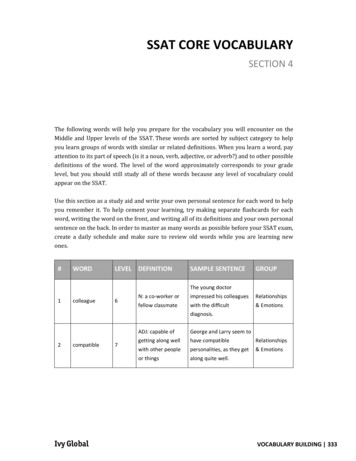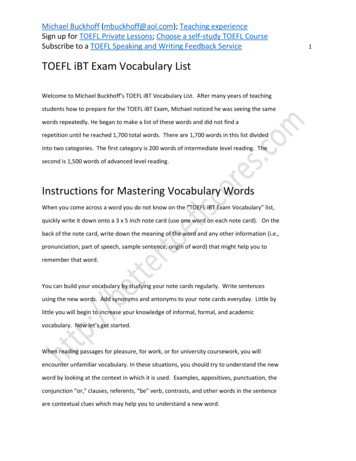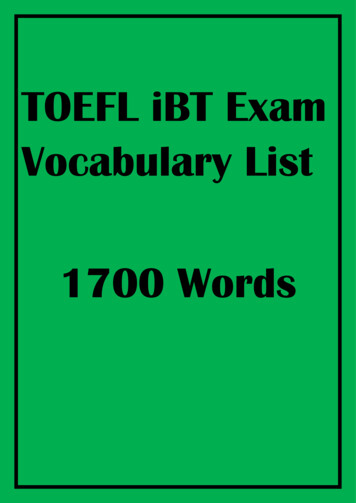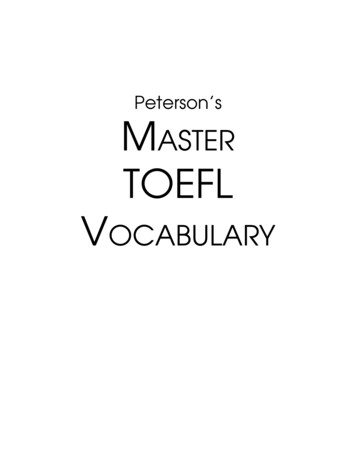
Transcription
Peterson’sMASTERTOEFLVOCABULARY
About Peterson’s, A Nelnet CompanyPeterson’s (www.petersons.com) is a leading provider of education information and advice, with books andonline resources focusing on education search, test preparation, and financial aid. Its Web site offers searchabledatabases and interactive tools for contacting educational institutions, online practice tests and instruction, andplanning tools for securing financial aid. Peterson’s serves 110 million education consumers annually.For more information, contact Peterson’s, A Nelnet Company, 2000 Lenox Drive, Lawrenceville, NJ 08648; 800338-3282; or find us on the World Wide Web at: www.petersons.com/aboutPortions of this book were previously published in Reading and Vocabulary Workbook for the TOEFL Examand Ultimate Word Success. 2006 by Elizabeth Davy and Karen DavyTOEFL is a registered trademark of Educational Testing Service (ETS). This book is not endorsed orapproved by ETS.Editor: Wallie Walker Hammond; Manufacturing Manager: Ray GolaszewskiALL RIGHTS RESERVED. No part of this work covered by the copyright herein may be reproduced or usedin any form or by any means—graphic, electronic, or mechanical, including photocopying, recording, taping,Web distribution, or information storage and retrieval systems—without the prior written permission of thepublisher.ISBN-13: 978-0-7689-2328-5ISBN-10: 0-7689-2328-XPrinted in the United States of America10 9 8 7 6 5 4 3 2 1 08 07 06First Edition
Petersons.com/publishingCheck out our Web site at www.petersons.com/publishing to see if there is any new informationregarding the test and any revisions or corrections to the content of this book. We’ve made surethe information in this book is accurate and up-to-date; however, the test format or content mayhave changed since the time of publication.
OTHER TITLES IN SERIES:Peterson’s Master TOEFL ReadingPeterson’s Master TOEFL Writing Skills
Contents Before You Begin . . . . . . . . . . . . . . . . . . . . . . . . . . . . . . . . . . . . . . . . . viiHow This Book Is Organized . . . . . . . . . . . . . . . . . . . . . . . . . . . . . . . . . viiSpecial Study Features . . . . . . . . . . . . . . . . . . . . . . . . . . . . . . . . . . . . . . viiYou’re Well on Your Way to Success . . . . . . . . . . . . . . . . . . . . . . . . . . . viiiGive Us Your Feedback . . . . . . . . . . . . . . . . . . . . . . . . . . . . . . . . . . . . . viiiTop 10 Strategies to Raise Your Score . . . . . . . . . . . . . . . . . . . . . . . . . . . ixPART I: TOEFL VOCABULARY BASICS1All About TOEFL Vocabulary . . . . . . . . . . . . . . . . . . . . . . . . . . . . . 3Vocabulary on the TOEFL . . . . . . . . . . . . . . . . . . . . . . . . . . . . . . . . . . . . 3Strategies for Learning and Remembering New Words . . . . . . . . . . . . . 3Summing It Up . . . . . . . . . . . . . . . . . . . . . . . . . . . . . . . . . . . . . . . . . . . . 18PART II: DIAGNOSING STRENGTHS AND WEAKNESSES2Practice Test 1: Diagnostic . . . . . . . . . . . . . . . . . . . . . . . . . . . . . 23Answer Key and Explanations . . . . . . . . . . . . . . . . . . . . . . . . . . . . . . . . 25PART III: TOEFL VOCABULARY REVIEW3Words in Context . . . . . . . . . . . . . . . . . . . . . . . . . . . . . . . . . . . . . 29Strategies for Defining Words from Context . . . . . . . . . . . . . . . . . . . . . 29Exercises . . . . . . . . . . . . . . . . . . . . . . . . . . . . . . . . . . . . . . . . . . . . . . . . . 50Answer Key . . . . . . . . . . . . . . . . . . . . . . . . . . . . . . . . . . . . . . . . . . . . . . . 57Summing It Up . . . . . . . . . . . . . . . . . . . . . . . . . . . . . . . . . . . . . . . . . . . . 594Everyday and Specific Vocabulary . . . . . . . . . . . . . . . . . . . . . 61Strategies for Learning Related Words . . . . . . . . . . . . . . . . . . . . . . . . . 61How Thoughts Are Related . . . . . . . . . . . . . . . . . . . . . . . . . . . . . . . . . . . 61Exercises . . . . . . . . . . . . . . . . . . . . . . . . . . . . . . . . . . . . . . . . . . . . . . . . . 86Answer Key . . . . . . . . . . . . . . . . . . . . . . . . . . . . . . . . . . . . . . . . . . . . . . . 90Summing It Up . . . . . . . . . . . . . . . . . . . . . . . . . . . . . . . . . . . . . . . . . . . . 915All About Roots . . . . . . . . . . . . . . . . . . . . . . . . . . . . . . . . . . . . . . 93Word Roots . . . . . . . . . . . . . . . . . . . . . . . . . . . . . . . . . . . . . . . . . . . . . . . 93Strategies for Learning Roots . . . . . . . . . . . . . . . . . . . . . . . . . . . . . . . . 93How Roots Work . . . . . . . . . . . . . . . . . . . . . . . . . . . . . . . . . . . . . . . . . . . 94v
viContents Learning Words with Greek Roots . . . . . . . . . . . . . . . . . . . . . . . . . . . . . 97 Learning Words with Latin Roots . . . . . . . . . . . . . . . . . . . . . . . . . . . . 101 Exercises . . . . . . . . . . . . . . . . . . . . . . . . . . . . . . . . . . . . . . . . . . . . . . . . 110 Answer Key . . . . . . . . . . . . . . . . . . . . . . . . . . . . . . . . . . . . . . . . . . . . . . 1146All About Prefixes . . . . . . . . . . . . . . . . . . . . . . . . . . . . . . . . . . . 117 Summing It Up . . . . . . . . . . . . . . . . . . . . . . . . . . . . . . . . . . . . . . . . . . . 115 Prefixes . . . . . . . . . . . . . . . . . . . . . . . . . . . . . . . . . . . . . . . . . . . . . . . . . 117 Strategies for Learning Prefixes . . . . . . . . . . . . . . . . . . . . . . . . . . . . . 117 How Prefixes Work . . . . . . . . . . . . . . . . . . . . . . . . . . . . . . . . . . . . . . . . 118 Learning Words with Greek Prefixes . . . . . . . . . . . . . . . . . . . . . . . . . . 121 Learning Words with Latin Prefixes . . . . . . . . . . . . . . . . . . . . . . . . . . 127 Prefixes for Numbers . . . . . . . . . . . . . . . . . . . . . . . . . . . . . . . . . . . . . . 133 Anglo-Saxon Prefixes . . . . . . . . . . . . . . . . . . . . . . . . . . . . . . . . . . . . . . 133 Exercises . . . . . . . . . . . . . . . . . . . . . . . . . . . . . . . . . . . . . . . . . . . . . . . . 135 Answer Key . . . . . . . . . . . . . . . . . . . . . . . . . . . . . . . . . . . . . . . . . . . . . . 1407All About Suffixes . . . . . . . . . . . . . . . . . . . . . . . . . . . . . . . . . . . . 143Suffixes . . . . . . . . . . . . . . . . . . . . . . . . . . . . . . . . . . . . . . . . . . . . . . . . . 143Strategies for Learning Suffixes . . . . . . . . . . . . . . . . . . . . . . . . . . . . . 143How Suffixes Work . . . . . . . . . . . . . . . . . . . . . . . . . . . . . . . . . . . . . . . . 144Suffixes That Describe State of Being . . . . . . . . . . . . . . . . . . . . . . . . . 148Suffixes That Indicate Occupations . . . . . . . . . . . . . . . . . . . . . . . . . . . 150Suffixes That Show Resemblance . . . . . . . . . . . . . . . . . . . . . . . . . . . . 152Suffixes That Show Amount . . . . . . . . . . . . . . . . . . . . . . . . . . . . . . . . . 155Twelve Useful Suffixes . . . . . . . . . . . . . . . . . . . . . . . . . . . . . . . . . . . . . 155Exercises . . . . . . . . . . . . . . . . . . . . . . . . . . . . . . . . . . . . . . . . . . . . . . . . 159Answer Key . . . . . . . . . . . . . . . . . . . . . . . . . . . . . . . . . . . . . . . . . . . . . . 164Summing It Up . . . . . . . . . . . . . . . . . . . . . . . . . . . . . . . . . . . . . . . . . . . 166PART IV: TWO PRACTICE TESTSPractice Test 2 . . . . . . . . . . . . . . . . . . . . . . . . . . . . . . . . . . . . . . 171Answer Key and Explanations . . . . . . . . . . . . . . . . . . . . . . . . . . . . . . . 176Practice Test 3 . . . . . . . . . . . . . . . . . . . . . . . . . . . . . . . . . . . . . . 181Answer Key and Explanations . . . . . . . . . . . . . . . . . . . . . . . . . . . . . . . 186 Summing It Up . . . . . . . . . . . . . . . . . . . . . . . . . . . . . . . . . . . . . . . . . . . 142 www.petersons.com
Before You Begin HOW THIS BOOK IS ORGANIZEDIf you are preparing for any version of the TOEFL, you are not alone. Almost amillion people all over the world took the TOEFL last year. A high score on thistest is an essential step in being admitted to undergraduate or graduateprograms at almost all colleges and universities in North America. But preparing for this test can be a difficult, often frustrating, experience.Peterson’s Master TOEFL Vocabulary, used as a self-tutor, will help you improveyour vocabulary skills. You’ll learn many of the “right” words—words you don’talready know but that are likely to appear on your test. Top 10 Strategies to Raise Your Score gives you test-taking strategies.Part I provides TOEFL vocabulary basics, including strategies for learningand remembering new words. Part II provides a diagnostic test to determine your strengths and weaknesses. Part III provides the basic vocabulary review. The words you’ll encounterstart with those that are relatively simple. They become relatively difficultas you continue through the book. Various learning strategies, such aslearning root words, are reviewed. Part IV consists of two additional practice vocabulary tests. They will showyou how well you have mastered the vocabulary skills presented in this book.SPECIAL STUDY FEATURESPeterson’s Master TOEFL Vocabulary is designed to be user-friendly. To thisend, it includes features to make your preparation much more efficient.OverviewThe review chapters begin with a bulleted overview, listing the topics to becovered in the chapter. This will allow you to quickly target the areas in whichyou are most interested.vii
viiiBefore You Begin Bonus InformationAs you work your way through the book, keep your eyes on the margins to find the following:NOTENotes highlight critical information about improving your vocabulary.TIPTips draw your attention to valuable concepts, advice, and shortcuts for tackling theharder vocabulary words.Summing It UpThe review chapter ends with a point-by-point summary that captures the mostimportant concepts. They are a convenient way to review the chapter’s key points.Practice TestsThe three practice tests, including the diagnostic test, are designed to help you preparewith little anxiety.YOU’RE WELL ON YOUR WAY TO SUCCESSThe TOEFL tests your vocabulary with “vocabulary-in-context” questions in which youmust determine the meaning of words as used in a specific sentence, as well as indirectlythrough the use of reading comprehension passages and questions. The more words youknow, the better your chances of narrowing down the choices to the correct one.Peterson’s Master TOEFL Vocabulary will help you to fine tune your vocabulary skills.GIVE US YOUR FEEDBACKPeterson’s publishes a full line of resources to help guide international students throughthe college admission process.We welcome any comments or suggestions you may have about this publication andinvite you to complete our online survey at www.petersons.com/booksurvey. Or you canfill out the survey at the back of this book, tear it out, and mail it to us at: Your feedback will help us to provide personalized solutions for your educationaladvancement. Publishing DepartmentPeterson’s2000 Lenox DriveLawrenceville, NJ 08648 www.petersons.com
Before You Begin ix TOP 10 STRATEGIES TO RAISE YOUR SCORE1.As with other sections of the TOEFL, be familiar with the directions and examplesso you can begin work immediately.2.For each passage, begin by briefly looking over the questions (but not the answerchoices). Try to keep these questions in mind during your reading.3.Scan passages to find and highlight the important facts and information.4.Read each passage at a comfortable speed.5.Answer the questions, referring to the passage when necessary.6.Eliminate answers that are clearly wrong or do not answer the question. If morethan one option remains, guess.7.Mark difficult or time-consuming answers so that you can come back to them laterif you have time.8.Timing is an important factor. Don't spend more than 10 minutes on any one readingand the questions about it.9.Concentration is another important factor. The reading section is one of the longersections of the test. Your practice and hard work will help you.10. Relax the night before the exam.www.petersons.com
PART I TOEFL VOCABULARYBASICS CHAPTER 1 All About TOEFL Vocabulary
All About TOEFLVocabulary Vocabulary on the TOEFL Strategies for learning and remembering new words Summing it upVOCABULARY ON THE TOEFLTOEFL vobabulary questions ask you to identify the meanings of words and phrasesthat appear in the reading passages. The words and phrases that are tested areimportant to understanding the entire passage, and, for the most part, you will haveto figure out their meanings. On the TOEFL iBT, however, if there are technical orunusual words in the passage, you will see the definition presented in a box.STRATEGIES FOR LEARNING AND REMEMBERING NEWWORDSReadReading is probably the single best way to improve your vocabulary. When you’repreparing for the TOEFL, read materials that contain the words that you aremost likely to encounter.Use a Dictionary and ThesaurusIf you’re serious about improving your testworthy vocabulary, you must have(and use!) a good dictionary. (A good thesaurus also helps a lot, but more on thatlater.) A dictionary is an alphabetical reference list of the words in the language.3 chapter 1OVERVIEW
4PART I: TOEFL Vocabulary Basics A dictionary entry always includes the following components: SpellingPronunciationPart(s) of speechIrregular forms of the wordDefinitionEtymology (the derivation and development of words)An entry may also contain synonyms and antonyms of the word; prefixes, suffixes, andother elements in word formation; and abbreviations.Most people think that all dictionaries are the same. After all, all dictionaries are chockfull of words listed in alphabetical order. They all have pronunciation guides, worddefinitions, and word histories. However, all dictionaries are not the same. Differenttypes of dictionaries fit different needs.For example, dictionaries have been written just for scholars who research the historyof language. The most famous scholarly dictionary is The Oxford English Dictionary. Anunabridged dictionary, the OED (as it’s often called) contains more than 500,000entries. Don’t rush right out to buy one to stash in your bookcase, however, because theOED now contains about 60 million words in 20 volumes. If shelf space is an issue andyou simply can’t live without an OED, however, online and CD-ROM versions areavailable from www.oed.com.Dictionaries have been created just for adults, college students, high school students,and elementary school students, too. The following list includes the bestselling generaldictionaries and the Web addresses for the online versions, when available: The American Heritage Dictionary of the English Language (Houghton Mifflin Co.:www.bartleby.com/61) Merriam-Webster’s Collegiate Dictionary (Merriam-Webster, Inc.: www.m-w.com/dictionary.htm) Merriam-Webster’s Pocket Dictionary (Merriam-Webster, Inc.)The New Shorter Oxford English Dictionary (Oxford University Press, Inc.)The Random House College Dictionary (Random House, Inc.)Webster’s New World College Dictionary (Hungry Minds, Inc.)Which dictionary should you purchase and use? Since more than 30,000 dictionaries arecurrently offered for sale online, you’ve got some shopping to do. Here’s what you need: A dictionary that contains all the words that you are likely to encounter onstandardized tests. This will most likely be the same dictionary that you can usein college, in your personal life, and in your professional life. www.petersons.com
Chapter 1: All About TOEFL Vocabulary 5 The words explained in terms that you can understand. An online dictionary can’t fulfill all your needs, unless you like to tote around yourlaptop and fire it up all the time. Always have a print dictionary to use, even if youhave an online version. When you’re trying to find a word in the dictionary, always begin by making an educatedguess as to its spelling. The odds are in your favor. However, the more spelling patternsyou know for a sound, the better your chances of finding the word quickly. You can finda pronunciation chart in the beginning of any dictionary. Once you’ve narrowed downyour search and you’re flipping through the pages, use the guide words, located on theupper-corners of the pages, to guide your search. Then, follow strict alphabetical order. A size that fits your needs. You might wish to buy a hardbound dictionary to useat home when you study and a smaller paperback to keep in your backpack orbriefcase for immediate reference. definitions plural part of speech etymology(word history)can-dy (kan’de), n. pl. -dies, v., -died, -dying. —n. 1. anyof a variety of confections made with sugar, syrup, etc.combined with other ingredients. 2. a single piece of such aconfection. —vt: 3. to cook in sugar or syrup, as sweetpotatoes or carrots. 4. to cook in heavy syrup until transparent, as fruit, fruit peel, or ginger. 5. to reduce (sugar, syrup,etc.) to a crystalline form, usually by boiling down. vi: tobecome candied. see vt. [ME sugre candy candied sugar MF sucre candi; candi Ar qandi or sugar qand sugar( Pers; perh. orig. piece of sugar candy; if so, akin to Sktkhanda piece)] spelling,pronunciation The following diagram shows how to read a sample entry.The part of speech is indicated by the n. It’s an abbreviation for “noun.” Look at thethird entry. The vt: right before the 3. shows that the word can be used as atransitive verb (a verb that must be followed by a direct object). The vi: at the endof the fifth entry shows that the word can also be used as an intransitive verb (a verbthat does not need a direct object to make sense in a sentence). The pl. at the beginning of the entry shows how you can make the word plural (morethan one). Here, the singular “candy” becomes the plural “candies.” Notice the pronunciation comes right after the entry word. It’s in parentheses—(kan’de). www.petersons.com Let’s look a little closer at the entry:
6PART I: TOEFL Vocabulary Basics The definitions follow the plural forms of the word. The word “candy” has severaldifferent meanings. They are arranged by the part of speech: the first definitionsshow what “candy” means when used as a noun; the second group shows what“candy” means when used as a verb. The information at the very end of the entry is the etymology or history of the word.This shows how the word was formed and came into English.A thesaurus is a reference book that contains synonyms and antonyms. The wordthesaurus comes from a Greek word that means “collection” or “treasure.” A thesaurusis especially helpful when you’re trying to express an idea but you don’t know how tophrase it. It is also a helpful reference book when you are trying to find a better wordthan the one you’ve been using. This helps you state exact shades of meaning ratherthan approximations. As a result, your vocabulary increases by heaps and heaps ofwords. This is clearly a big advantage when it comes to preparing for a standardizedtest.In a thesaurus, words with similar meanings are grouped together. To find a synonymfor a word in a traditional print thesaurus, you must use the index at the back of thebook. However, new editions and online versions of a thesaurus are arranged like adictionary in alphabetical order.If you look up the word exciting in a print thesaurus, you would find this entry:excitement [n] enthusiasm; incitementaction, activity, ado, adventure, agitation, animation, bother,buzz*, commotion, confusion, discomposure, disturbance, dither*,drama, elation, emotion, excitation, feeling, ferment, fever, flurry,frenzy, furor, fuss, heat*, hubbub*, hullabaloo, hurry, hysteria,impulse, instigation, intoxication, kicks*, melodrama, motivation, motive, movement, passion, perturbation, provocation, rage,stimulation, stimulus, stir, thrill, titillation, to-do, trepidation,tumult, turmoil, urge, warmth, wildness. SEE CONCEPTS 38,410, 633.SEE CONCEPTS in the print thesaurus takes you to the Concept Index, which helps youlink different related ideas. In this way, you can find the exact shade of meaning youneed. Use the key in the beginning of the print thesaurus to understand differentsymbols. In this entry, for example, the * shows that a word is colloquial or the slanglevel of usage.Online thesaurus programs are especially useful for distinguishing among homonyms.If you intended to type “whether” but instead keyboarded “weather,” the thesaurus willgive you synonyms like atmospheric conditions, climate, meteorology, and the elements.This can help you keep your homonyms straight. www.petersons.com
Chapter 1: All About TOEFL Vocabulary 7 While both a print and an online thesaurus unquestionably will help you beef up yourvocabulary, in general, a print thesaurus will give you more options than an onlinethesaurus. That’s because the print versions have more words in them. Therefore, you’llneed a print thesaurus even if you have an online version. Use a print thesaurus whenyou need a wider variety of choices. www.petersons.com How well do you pronounce testworthy words? Take the following self-test to see. Coverthe third column with a piece of paper. Then read each word and its definition.Pronounce each word. Last, check the third column to see how well you did. The most effective way to learn how to pronounce new words is by using a dictionary.Get a reliable desk or pocket dictionary. It’s the best source for the words you need toget you where you want to go. Even the lowly word picture can get warped as pitcher. As a result, no one knows whatanyone else is talking about. Incorrect pronunciations can make it impossible to definethe word, too. In addition, people often insert an extra letter or two, which can make the wordunrecognizable. For instance, ambidextrous (able to use either hand) has four syllablesand is correctly pronounced am-bi-deks-trus. But sometimes speakers add an extrasyllable to get am-bi-deks-tree-us or am-bi-deks-tru-us. The pronunciation problem is especially acute with words that can function as morethan one part of speech. The word ally is a case in point. As a noun, it’s pronounced aleye. As a verb, it’s pronounced uh-lie. People have also been known to drop letters. For instance, the food poisoning known assalmonella is correctly pronounced sal-muh-nel-uh. Dropping the L results in sam-uhnel-uh. Knowing the meaning of a word is only half the battle; you also have to know how topronounce it. It’s astonishing how many words are misunderstood simply because theyare mispronounced. Words get mangled in surprisingly inventive ways. For example,people often switch letters. For example, abhor (hate) becomes uh-bor rather than ab-hor. Pronounce Words Correctly
8PART I: TOEFL Vocabulary Basics WordMeaningPronunciationAmishPennsylvania Dutchah-mishaplombassuranceuh-plahmawrywrong, e mealbuh-faybuoyfloating day-noo-mahentrepreneurbusiness personahn-truh-pruh-nurfracasnoisy iantcarefreein-soo-see-intkhakilight brownkak-eelarynxvoice nich (rhymes with fter npaymentri-myoo-nuh-ray-shinshallotonionshal-it or shuh-lahttoupeehairpiecetoo-payvehementfiery, dyarnwuus-tidUse Word CardsOne of the most effective ways to make a word your own is through repetition. Going overthe word can help you master its meaning as well as pronunciation and usage. Try thisidea: buy a stack of 3 5 index cards.As you read through the following chapters, write each difficult word on the front of anindex card, one word per card. Then, write the definition on the back. Here’s a sample: www.petersons.com
Chapter 1: All About TOEFL Vocabulary 9 FRONT: matriarch BACK: the female head ofa family or tribeSynonymAntonym www.petersons.com 1. adapt2. authentic3. chronic4. conquer5. frustrate6. indulge7. naïve8. punish9. relinquish10. sullen Word Complete the following chart by writing at least one synonym and antonym for eachword. Then, see how many more synonyms and antonyms you can brainstorm. Possibleanswers follow. Synonyms are words that are nearly the same in meaning as other words. Antonyms arewords that are opposites. Learning different synonyms and antonyms can help youswell your vocabulary. Go ahead and try it now. Learn Synonyms and Antonyms
10PART I: TOEFL Vocabulary Basics Suggested answers:WordSynonymsAntonyms1. adaptadjust, accustom, accommodatedisarrange, dislocate2. authenticgenuine, real, legitimatefake, counterfeit, bogus,imitation3. chronichabitual, ongoing, constantone time, single4. conquerdefeat, vanquish, overwhelmsurrender, yield, forfeit, give up5. frustratebaffle, beat, disappointfacilitate, encourage6. indulgetolerate, humor, allow, permitprohibit, deter, restrain, enjoin7. naïveinnocent, ingenuousworldly, urbane, suave8. punishdiscipline, castigatereward, compensate,remunerate9. relinquishquit, renounceperpetuate, keep10. sullenirritable, morose, moodycheerful, jolly, blithe, happyUnderstand a Word’s Unstated MeaningsEvery word has a denotation, its dictionary meaning. In addition, some words haveconnotations, their understood meanings or emotional overtones. For example, bothhouse and home have the same denotation, a shelter. Home, however, carries aconnotation of warmtl!and love not present in house.Use Word PartsA surprisingly large number of words can be divided into parts that you can figure outeasily. If you can define the parts, then you can often decode the entire word. This is acrucial skill on standardized tests, when you’re under time constraints.There are three main word parts to know: roots, prefixes, and suffixes. A root is a base or stem form of many words. Roots are covered in depth in Chapter 5.A prefix is a letter or a group of letters placed at the beginning of a word to changeits meaning. Prefixes are covered in depth in Chapter 6. A suffix is a letter or a group of letters placed at the end of a word to change itsmeaning. Suffixes are covered in depth in Chapter 7.For example, if you know the Latin root ami means “like” or “love,” you can easily figureout that amiable means “pleasant and friendly.” Similarly, you could deduce thatamorous means “loving.” Even if you can’t define a word exactly, recognizing thedifferent parts of the word still will give you a general idea of the word’s meaning. www.petersons.com
Chapter 1: All About TOEFL Vocabulary 11 Create your own mnemonics to help you remember the easily confused words that youare most likely to encounter on standardized tests. Likewise, stationary means “standing still” (both words stationary and standingcontain an “a”) while stationery is paper used for writing letters (both words stationeryand letter contain “er”). Desert and dessert become easier to define when you rememberthat dessert has a double “s,” like strawberry shortcake. Mnemonics are memory tricks that help you remember everything from the order of theplanets to your grocery list. Mnemonics are another technique you can use to help youdistinguish between easily confused words. For example, to remember that principal means“main” (as in the principal of a school), look at the last three letters: the principal is your pal.To remember that principle means “rule,” remember that both words end in le. Use Mnemonics How can you figure out that maritime must mean “related to the sea, nautical”? Usecontext clues: Just after midnight on April 15, 1912, one of the most dramatic and famous of allmaritime disasters occurred, the sinking of the Titanic. The Titanic was the mostluxurious ship afloat at the time, with its beautifully decorated staterooms,glittering crystal chandeliers, and elaborate food service. When you take standardized tests, you’ll be expected to d
OTHER TITLES IN SERIES: Peterson's Master TOEFL Reading Peterson's Master TOEFL Writing Skills

